
SyncMaster 152x/172x

SyncMaster 152x/172x

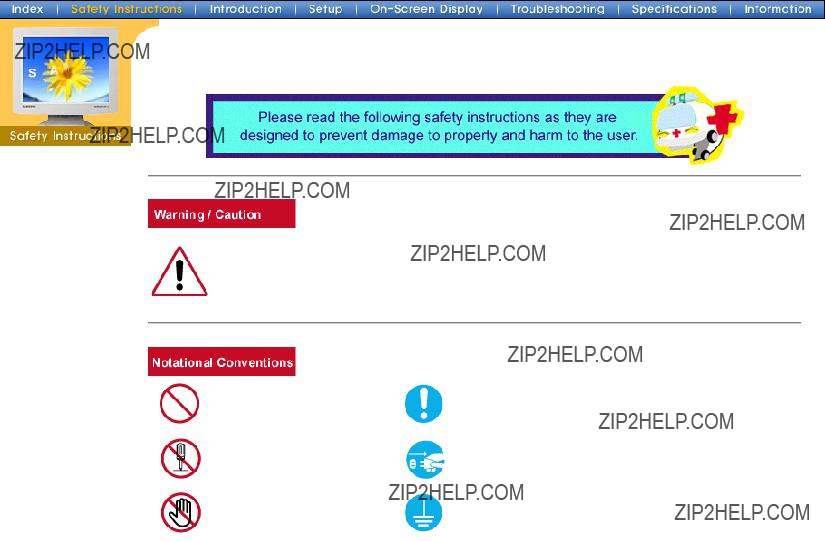
 Notational
Notational
 Power
Power
 Installation
Installation
 Clean
Clean
 Other
Other
Failure to follow directions noted by this symbol could result in bodily harm or damage to equipment.
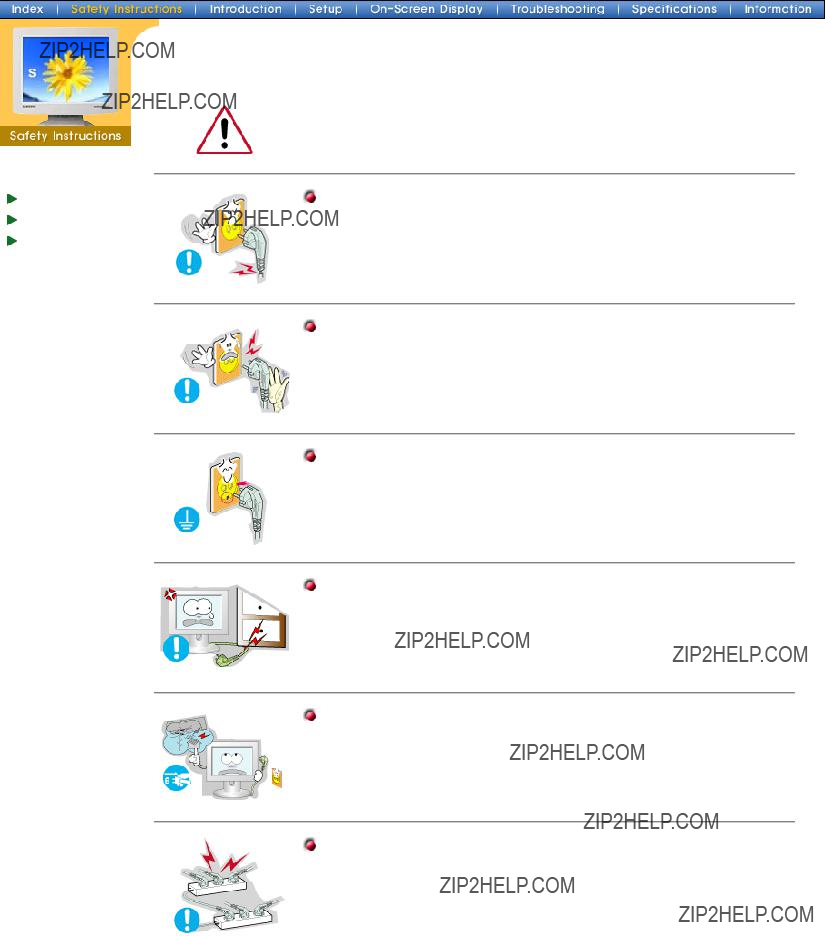
When not used for extended periods of time, set your PC to DPMS. If using a screen saver, set it to the active screen mode.
 Notational
Notational
 Power
Power
Clean
Other
z This may cause an electric shock or fire.
Do not pull the plug out by the wire nor touch the plug with wet hands.
z This may cause an electric shock or fire.
Use only a properly grounded plug and reoeptacle.
zAn improper ground may cause electric shock or equipment damage.
Do not excessively bend the plug and wire nor place heavy objects upon them, which could cause damage.
z Failure to do so may cause an electric shock or fire.
Disconnect the plug from the outlet during storms or lightening or if it is not used for a long period of time.
z Failure to do so may cause an electric shock or fire.
Do not connect too many extension cords or plugs to an outlet.
z This may cause a fire.

Do not cover the vents on the monitor cabinet.
z Bad ventilation may cause a breakdown or fire.
 Notational
Notational
 Power
Power
 Installation
Installation
Do not drop the monitor when moving it.
z This may cause damage to the product or human body.
Place the monitor on a flat and stable surface.
z The monitor can cause injury by falling.
Set down the monitor carefully.
z It could be damaged or broken.
Do not place the monitor face down.
z The CDT surface may be damaged.

When cleaning the monitor case or the surface of the
 Notational
Notational
 Power
Power
 Clean
Clean
 Other
Other
Use the recommended detergent with a smooth cloth.
If the connector between the plug and the pin is dusty or dirty, clean it properly with a dry cloth.
z A dirty connector can cause an electric shock or fire.
Do not set a glass of water, chemicals or any small metal objects on the monitor.
zThis may cause damage, electric shock or a fire.
zIf a foreign substance gets into the monitor, disconnect the plug and then contact a service center.

For each hour of looking at the monitor, you should let your eyes rest for 5 minutes.
z This will reduce eye fatigue.
Do not use or store inflammable substances near the monitor.
z This may cause an explosion or fire.
Do not try to move the monitor by pulling on the wire or the signal cable.
zThis may cause a breakdown, electric shock or a fire due to damage to the cable.
Do not move the monitor right or left by pulling only the wire or the signal cable.
zThis may cause a breakdown, electric shock or a fire due to damage to the cable.
Never insert anything metallic into the monitor openings.
z This may cause an electric shock, fire or injury.
Keep all power adaptors apart.

z Possible fire hazard.
Keep power adaptor away from any other heat source.
z Possible fire hazard.
Remove and discard vinyl bag from power adaptor before use.
z Possible fire hazard.
Always keep power adaptor in
If you view a fixed screen for an extended period of time, residual image or blurriness may appear.
zChange the mode to energy save or set a screensaver to moving picture when you need to be away from the monitor for an extended period of time.

SyncMaster 152x
Please make sure the following items are included with your monitor. If any items are missing, contact your dealer.
Unpacking
 Unpacking
Unpacking
 Front
Front
 Rear
Rear
User's Guide and Driver
Installation CD
VESA Mounting Bracket

SyncMaster 172x
Please make sure the following items are included with your monitor. If any items are missing, contact your dealer.
Unpacking
 Unpacking
Unpacking
 Front
Front
 Rear
Rear
DVI Cable
(Option)
Warranty Card
(Not available in all locations)
VESA Mounting Bracket
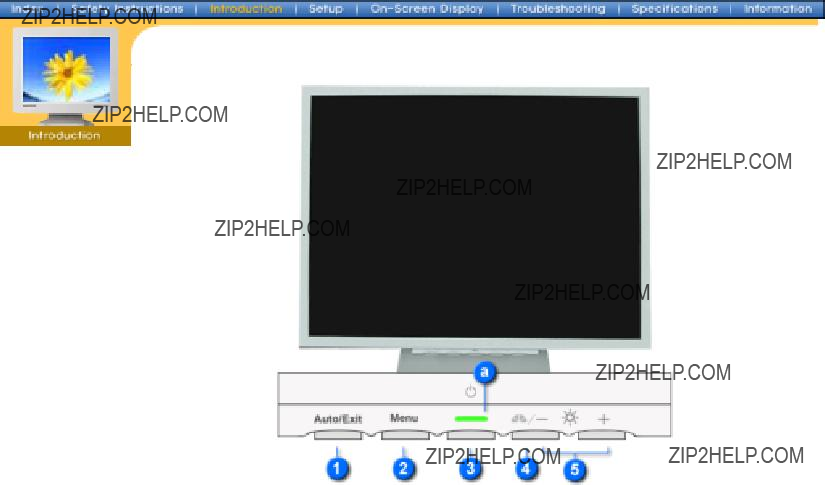
SyncMaster 152x
 Unpacking
Unpacking
 Front
Front
 Rear
Rear
1.Auto button Use this button to auto adjustment direct access. / / Exit button Use this button to Exit the active menu or the OSD.
2.Menu button Use this button to open the OSD and activate a highlighted menu item.
3.Power button Use this button to turn the monitor on and off.
4.MagicBright MagicBright is a new feature providing optimum viewing environment
Note: See PowerSaver described in the manual for further information regarding power saving functions. For energy conservation, turn your monitor OFF when it is not needed, or when leaving it unattended for long periods.

SyncMaster 172x
 Unpacking
Unpacking
 Front
Front
 Rear
Rear
1.Auto button Use this button to auto adjustment direct access.
2.Exit button Use this button to Exit the active menu or the OSD.
3.Menu button Use this button to open the OSD and activate a highlighted menu item.
4.Power button Use this button to turn the monitor on and off.
5.Adjust buttons These buttons allow you to highlight and adjust items in the menu.
6.MagicBright MagicBright is a new feature providing optimum viewing environment
a. Power indicator This light glows green during normal operation, and blinks green once as the monitor saves your adjustments.
Note: See PowerSaver described in the manual for further information regarding power saving functions. For energy conservation, turn your monitor OFF when it is not needed, or when leaving it unattended for long periods.

SyncMaster 152x
 Unpacking
Unpacking
 Front
Front
 Rear
Rear
(The configuration at the back of the monitor may vary from product to product.) 1. Power port
2. Signal port
Note: See Connecting Your Monitor for further information regarding cable connections.
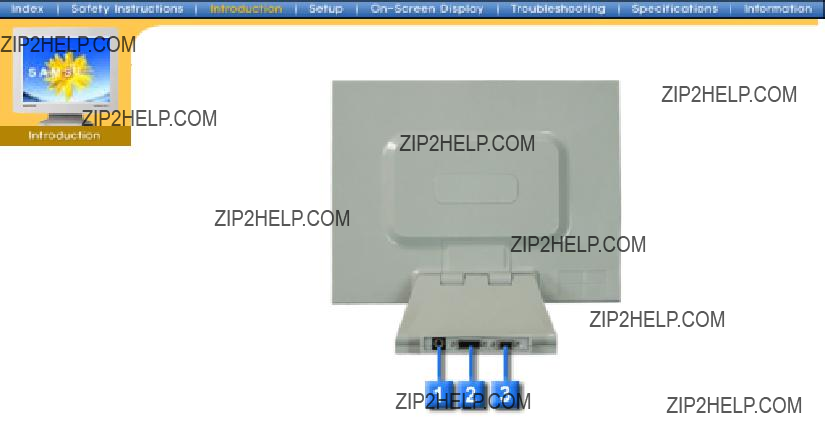
SyncMaster 172x
 Unpacking
Unpacking
 Front
Front
 Rear
Rear
(The configuration at the back of the monitor may vary from product to product.)
Note: See Connecting Your Monitor for further information regarding cable connections.

SyncMaster 152x
Connecting Your Monitor
 Using the Stand
Using the Stand
Connecting
Your Monitor
Installing the
Monitor Driver
1.Connect the DC Adapter for your monitor to the power port on the back of the monitor. Plug the power cord for the monitor into a nearby outlet.
2.Connect the signal cable to the
3.Connect the monitor to the Macintosh computer using the
4.In the case of an old model Macintosh, you need to connect the monitor using a special Mac adaptor.
5.Turn on your computer and monitor. If your monitor displays an image, installation is complete.

SyncMaster 172x
Connecting
Your Monitor
Installing the
Monitor Driver
1.Connect the DC Adapter for your monitor to the power port on the back of the monitor. Plug the power cord for the monitor into a nearby outlet.
Connect the signal cable to the
Connect the DVI Cable to the DVI Port on the back of your Monitor.
3.Connected to a Macintosh.
Connect the monitor to the Macintosh computer using the
4.In the case of an old model Macintosh, you need to connect the monitor using a special Mac adaptor.
5.Turn on your computer and monitor. If your monitor displays an image, installation is complete.
You may get a blank screen depending on the type of video card you are using, if you connect simultaneously both the
If you connect properly your monitor using the DVI connector but get a blank or fuzzy screen, check to see if the monitor status is set to analogue. Press Source button to have the monitor
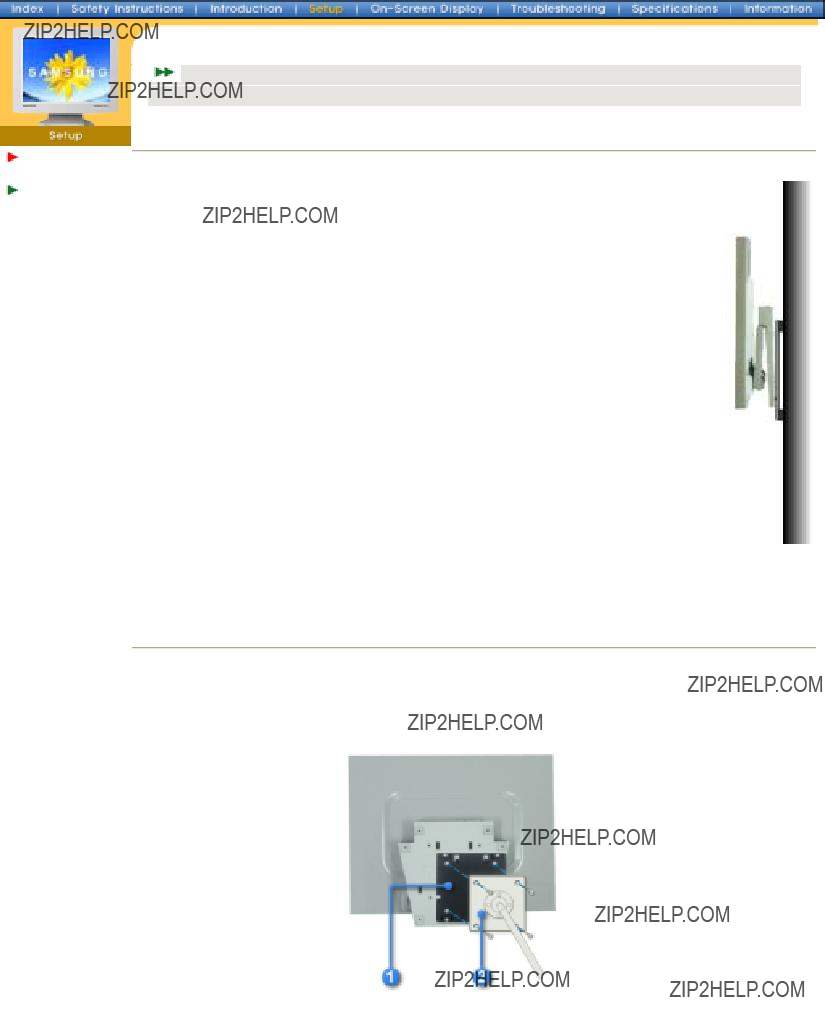
SyncMaster 152x/172x
Connecting Your Monitor
 Using the Stand
Using the Stand
Wall Mounting the Monitor | Attaching a base
Installing the
Monitor Driver
As shown in the figure above, you first fold the stand. You attach the VESA mounting brackets on the wall. You hang the monitor aligning its bottom grove with the bracket.
Attaching a base
NOTE: This monitor accepts a 75 mm x 75 mm
Squeeze the folded monitor stand into the VESA mounting bracket. Then fasten it using the four supplied nuts with the monitor, mounting pad and VESA mounting bracket aligned.
1.VESA Mounting Brkt
2.Mounting interface pad

Connecting Your
Monitor
Installing the
Monitor Driver
When prompted by the operating system for the monitor driver, insert the
Prepare a blank disk and download the driver program file at the Internet web site shown here.
z Internet web site :
 Windows ME
Windows ME
1.Insert CD into the
2.Click "Windows ME Driver".
3.Choose your monitor model in the model list, then click the "OK" button.
4. Click the "Install" button in the "Warning" window.
5. Monitor driver installation is completed.
 Windows XP/2000
Windows XP/2000
1.Insert CD into the
2.Click "Windows XP/2000 Driver".
3.Choose your monitor model in the model list, then click the "OK" button.
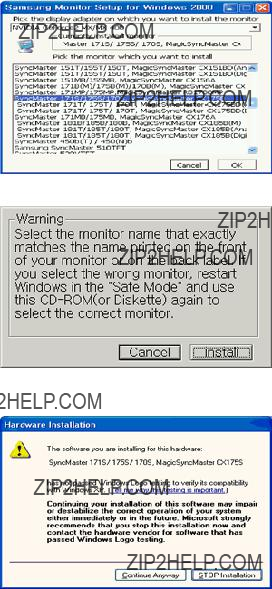
4. Click the "Install" button in the "Warning" window.
5.If you can see following "Message" window, then click the "Continue Anyway" button. Then click "OK" button.
This monitor driver is under certifying MS logo,and this installation don't damage your system.The certified driver will be posted on Samsung Monitor Homepage
6. Monitor driver installation is completed.

Connecting Your
Monitor
Installing the
Monitor Driver
When prompted by the operating system for the monitor driver, insert the
Prepare a blank disk and download the driver program file at the Internet web site shown here.
z Internet web site :
Microsoft?? Windows?? XP Operating System
1.Insert CD into the
2.Click "Start"
3. Click "Display" icon and choose the "Settings" tab then click "Advanced..".
4. Click the "Properties" button on the "Monitor" tab and select "Driver" tab.
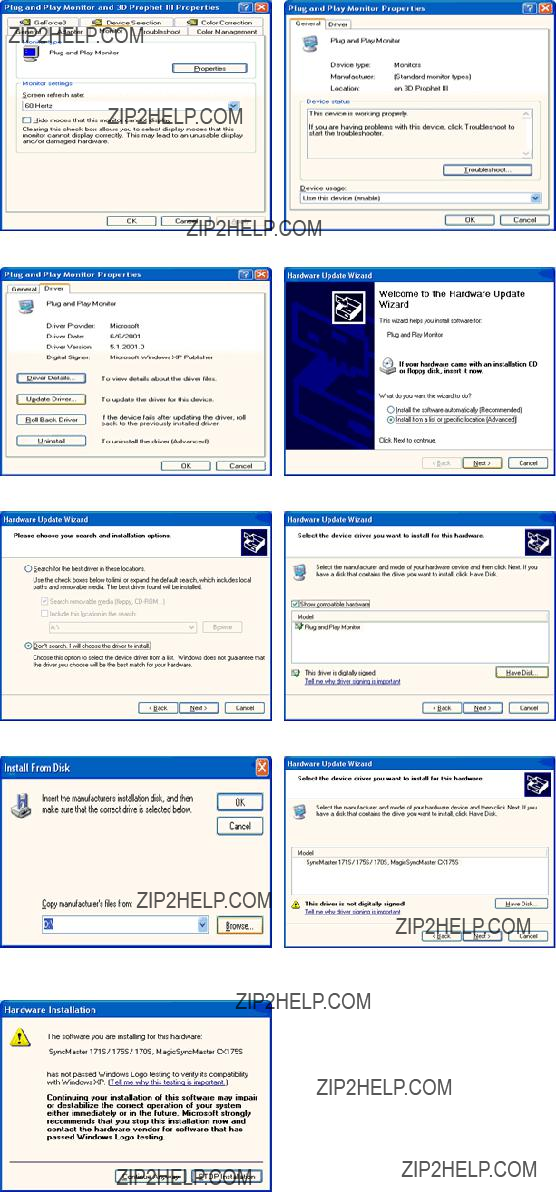
5. Click "Update Driver.." and select "Install from a list or.." then click "Next" button.
6. Select "Don't search ,I will.." then click "Next" and then click "Have disk".
7.Click the "Browse" button then choose A:(D:\Driver) and choose your monitor model in the model list and click the "Next" button.
8.If you can see following "Message" window, then click the "Continue Anyway" button. Then click "OK" button.
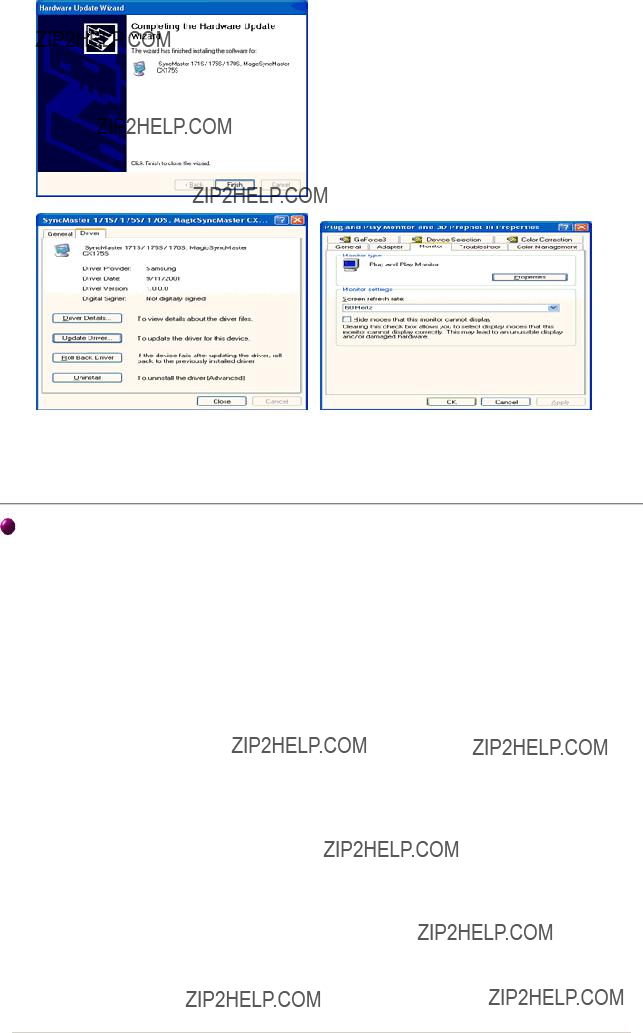
This monitor driver is under certifying MS logo,and this installation don't damage your system.The certified driver will be posted on Samsung Monitor Homepage
9. Click the "Close" button then click "OK" button continually.
10. Monitor driver installation is completed.
Microsoft?? Windows?? 2000 Operating System
 When you can see "Digital Signature Not Found" on your monitor, follow these steps.
When you can see "Digital Signature Not Found" on your monitor, follow these steps.
1.Choose "OK" button on the "Insert disk" window.
2.Click the "Browse" button on the "File Needed" window.
3.Choose A:(D:\Driver) then click the "Open" button and then click "OK" button.
 How to install
How to install
1.Click "Start" , "Setting" , "Control Panel".
2.Double click the "Display" Icon.
3.Choose the "Settings" tab and then click "Advanced..".
4.Choose "Monitor".
Case1: If the "Properties" button is inactive, it means your monitor is properly configured. Please stop installation
Case2: If the "Properties" button is active, click the "Properties" button then follow next steps continually.
5.Click "Driver" and then click on "Update Driver.." then click on the "Next" button.
6.Choose "Display a list of the known drivers for this device so that I can choose a specific driver" then click "Next" and then click "Have disk".
7.Click the "Browse" button then choose A:(D:\Driver).
8.Click the "Open" button, then click "OK" button.
9.Choose your monitor model and click the "Next" button then click "Next" button.
10.Click the "Finish" button then the "Close" button.
If you can see the "Digital Signature Not Found" window then click the "Yes"button. And click the "Finish" button then the "Close" button.
 Microsoft?? Windows?? Millennium Operating System
Microsoft?? Windows?? Millennium Operating System
1.Click "Start" , "Setting" , "Control Panel".
2.Double click "Display" icon.
3.Select the "Settings" tab and click "Advanced Properties" button.

4.Select the "Monitor" tab.
5.Click the "Change" button in the "Monitor Type" area.
6.Choose "Specify the location of the driver".
7.Choose "Display a list of all the driver in a specific location.." then click "Next" button.
8.Click the "Have Disk" button
9.Specify A:\(D:\driver) then click "OK" button.
10.Select "Show all devices" and choose the monitor that corresponds to the one you connected to your computer and click "OK".
11.Continue choosing "Close" button and "OK" button until you close the Display Properties dialogue box.
(You can get some other screen for warning message or others, then click the appreciate option for your monitor.)
 Microsoft?? Windows?? NT Operating System
Microsoft?? Windows?? NT Operating System
1.Click Start, Settings, Control Panel, and then
2.In Display Registration Information window, click Settings Tab and then click All Display Modes.
3.Select a mode that you wish to use (Resolution, Number of colors and Vertical frequency) and then click OK.
4.Click Apply button if you see the screen working normally after clicking Test. If the screen is not normal, change to a different mode (lower mode of resolution, colors or frequency).
Note: If there is no Mode at All Display Modes, select the level of resolution and vertical frequency by referring to the Preset Display Modes in the user guide.
 Linux Operating System
Linux Operating System
To execute
1.Press Enter at the first and the second screen after executing the X86Config file.
2.The third screen is for setting your mouse.
3.Set a mouse for your computer.
4.The next screen is for selecting a keyboard.
5.Set a Keyboard for your computer.
6.The next screen is for setting your monitor.
7.First of all, set a horizontal frequency for your monitor. (You can enter the frequency directly.)
8.Set a vertical frequency for your monitor. (You can enter the frequency directly.)
9.Enter the model name of your monitor. This information will not affect the actual execution of
10.You have finished setting up your monitor.
Execute
Align the Mounting Interface Pad with the holes in the Rear Cover Mounting Pad and secure it with the four screws that came with the

Connecting Your
Monitor
Installing the
Monitor Driver
MagicTune???
Installation
English > Main > Adjust Your Monitor > MagicTune??? Installation
1.Overview
2.System Requirements
3.
1.Overview- What is MagicTune???
Monitor performance can vary due to the graphics card, host computer, lighting conditions and other environmental factors. In order to get the best image on a monitor requires you to adjust it for your unique setting. Unfortunately, the manual controls available to tune the image often prove to be challenging. Proper adjustment (tuning) requires an easy to use program that goes through a step-
In most cases even simple adjustments to Brightness, or Contrast require navigation of the multi- level,
2. System Requirements
MagicTune??? is a software utility that allows monitor adjustment and color tuning using the Display Data Channel Command Interface (DDC/CI) protocol. All adjustments to the display are control via software to eliminate the need to use the monitor
zWindows 98 SE
zWindows Me
zWindows 2000 Professional
zWindows 2000 Server
zWindows XP Home Edition
zWindows XP Professional
MagicTune??? runs in the back ground and can be accessed through the task tray, start menu, or right click on the desktop. MagicTune??? allows for quick accurate tuning of the display with the ability to easily save and use monitor configurations that are best suited for you.
3.
1)Click the MagicTune??? installation file.
2)Starting installation. Click [Next]

3) The MagicTune??? License Agreement is displayed. Read the Terms of Agreement carefully. If you do not agree to the Terms of Agreement, you are not allowed to install MagicTune???.
If you click "Agree", the [Next] button becomes activated. Click [Next]
4) Select a location to install Magic Tune???. Then click.
5) Select Program Group to install MagicTune???. Then click .
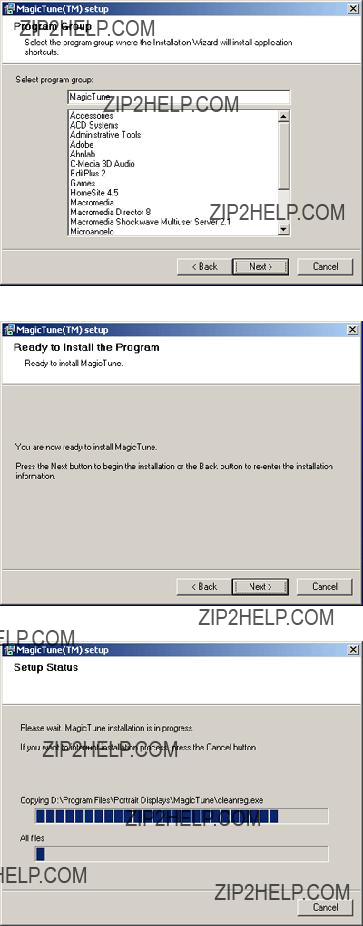
6) Click [Install] to start installing MagicTune???.
7) Install MagicTune??? in the selected location.
8) MagicTune??? has been successfully installed. Click [Finish].

(Start MagicTune??? > Click Support > Click Help Site)
 For more information about how to use the MagicTune???, see the Help Site of the MagicTune??? program. (http://personalcomputing.portrait.com/us/support/support_mt_ contents.html)
For more information about how to use the MagicTune???, see the Help Site of the MagicTune??? program. (http://personalcomputing.portrait.com/us/support/support_mt_ contents.html)
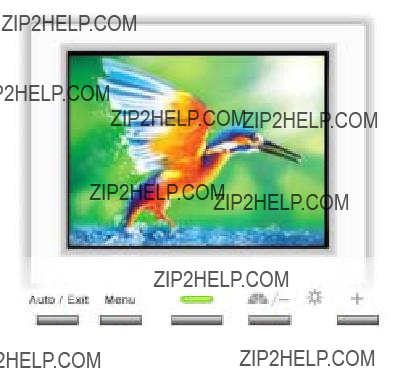
On Screen Display (OSD)
SyncMaster 152x
Auto :
Exit :
Use this button to auto adjustment direct access.
Use this button to Exit the active menu or OSD.
These buttons allows you to highlight and adjust items in the menu.
Use this button to open the OSD and activate a highlighted mene item.
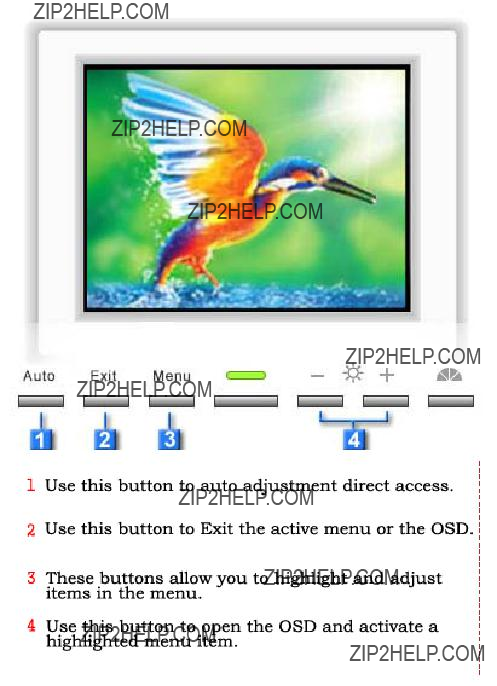
SyncMaster 172x

Brightness
MenuHow to adjust
Contrast
- Adjust Contrast.
1. Push the Menu button.
2. Push the [ - ] button or [ + ] button until the Contrast screen is displayed.
3. Push the Menu button to open the Contrast adjustment screen.
4. Use the [ + ] button to increase the contrast or [ - ] button to decrease the contrast.

Image Lock
Image Lock [Fine]
- Image Lock is used to fine tune and get the best image by removing noises that creates unstable images with jitters and shimmers.
If satisfactory results are not obtained using the Fine adjustment, use the Coarse adjustment and then use Fine again.
1. Push the Menu button.
2. Push the [ - ] button or [ + ] button until the Image Lock screen is displayed.
3. Push the Menu button twice to open the Fine adjustment screen.
4. Use the [ - ] button or [ + ] button to remove any noise.
Image Lock [Coarse]
- Image Lock is used to fine tune and get the best image by removing noises that creates unstable images with jitters and shimmers.
If satisfactory results are not obtained using the Fine adjustment, use the Coarse adjustment and then use Fine again.
1. Push the Menu button.
2. Push the [ - ] button or [ + ] button until the Image Lock screen is displayed.
3. Push the Menu button again and then press the [ - ] or [ + ] button until the Coarse screen appears.
4. Push the Menu button to open the Coarse adjustment screen.
5. Use the [ - ] button or [ + ] button to remove any noise.
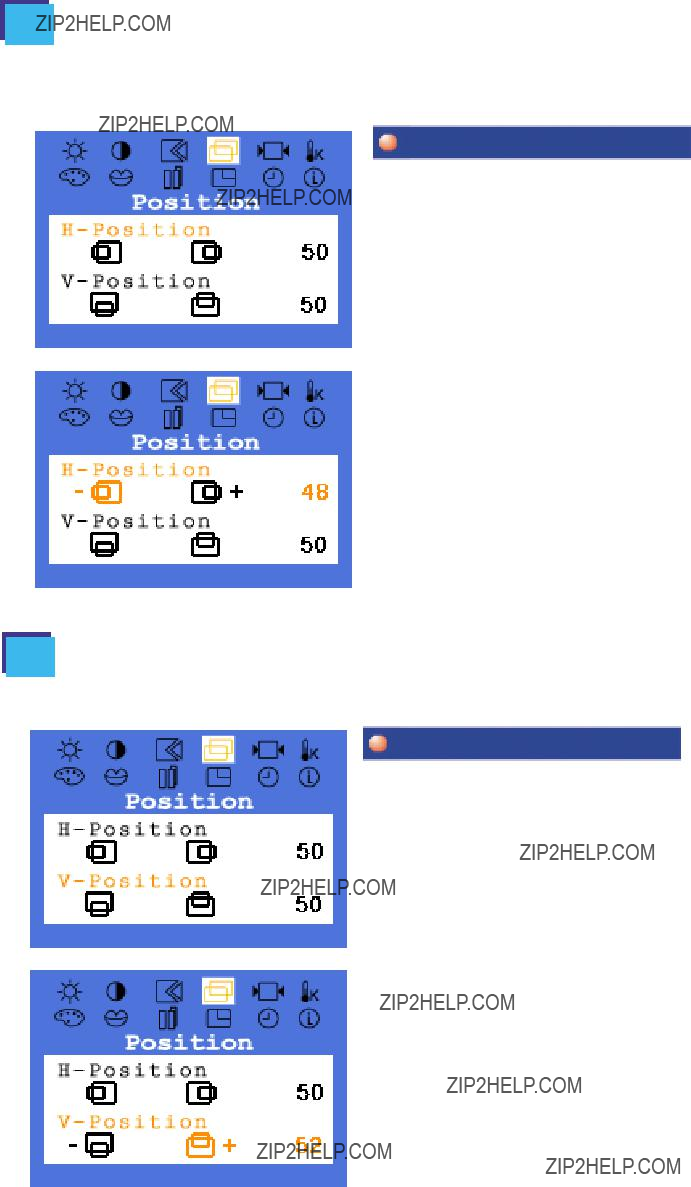
- Follow these instructions to change the horizontal position of the monitor's entire display.
1. Push the Menu button.
2. Push the [ - ] button or [ + ] button until the
3. Push the Menu button to open the
4. Use the [ - ] button or [ + ] button to change the horizontal position of the monitor's viewing area.
- Follow these instructions to change the vertical position of the monitor's entire display.
1. Push the Menu button.
2. Push the [ - ] button or [ + ] button until the
3. Push the Menu button to open the
4. Use the [ - ] button or [ + ] button to change the vertical position of the monitor's viewing area.

Reset
Reset [Geometry Reset]
- Geometry parameters are replaced with the factory default values.
1. Push the Menu button.
2. Push the [ - ] button or [ + ] button until the Reset screen is displayed.
3. Push the Menu button twice to open the Geometry Reset adjustment screen.
4. Push the [ + ] button to select Yes.
If you don't want to reset the monitor, use the [ - ] button to select No.
Reset [Color Reset]
- Color parameters are replaced with the factory default values.
1. Push the Menu button.
2. Push the [ - ] button or [ + ] button until the Reset screen is displayed.
3. Push the Menu button again and then press the - or + button until the Color Reset screen appears.
4. Push the [ + ] button to select Yes.
If you don't want to reset the monitor, use the [ - ] button to select No.

Color Temperature
Color Temperature
- Color temperature is a measure of the "warmth" of the image colors.
1. Push the Menu button.
2. Push the [ - ] button or [ + ] button until the Color Temperature screen is displayed.
3. Push the Menu button to open the Color Temperature adjustment screen.
4. Press the [ - ] button or [ + ] button to select User Adjusted, Reddish, Bluish or sRGB .
(When you adjust the Brightness and Contrast after sRGB mode is selected, sRGB mode exits)
Color Control
Color Tontrol
- Follow these steps to adjust individual R,G,B color control.
1. Push the Menu button.
2. Push the [ - ] button or [ + ] button until the Color Control screen is displayed.
3. Push the Menu button to open the Color Control adjustment screen.
Use the
G(reen_ or B(lue) and push the Menu button
4. Press the [ - ] button or [ + ] button to adjust the color setting

Halftone
Halftone
- Change the opaqueness of the background of the OSD.
1. Push the Menu button.
2. Push the [ - ] button or [ + ] button until the Halftone screen is displayed.
3. Push the Menu button to open the Halftone selection screen.
4. Use the [ - ] button or [ + ] button to select On or Off.
Language
Language
- Follow these steps to change the language used in the menu. You can choose one of ten languages. (English, German, Spanish, French, Italian, Swedish, Russian)
Note : The language chosen affects only the language of the OSD. It has no effect on any software running on the computer.
1. Push the Menu button.
2. Push the [ - ] button or [ + ] button until the Languages screen is displayed.
3. Push the Menu button to open the Languages selection screen.
4. Use the [ - ] button or [ + ] button to select the language you would like to use.
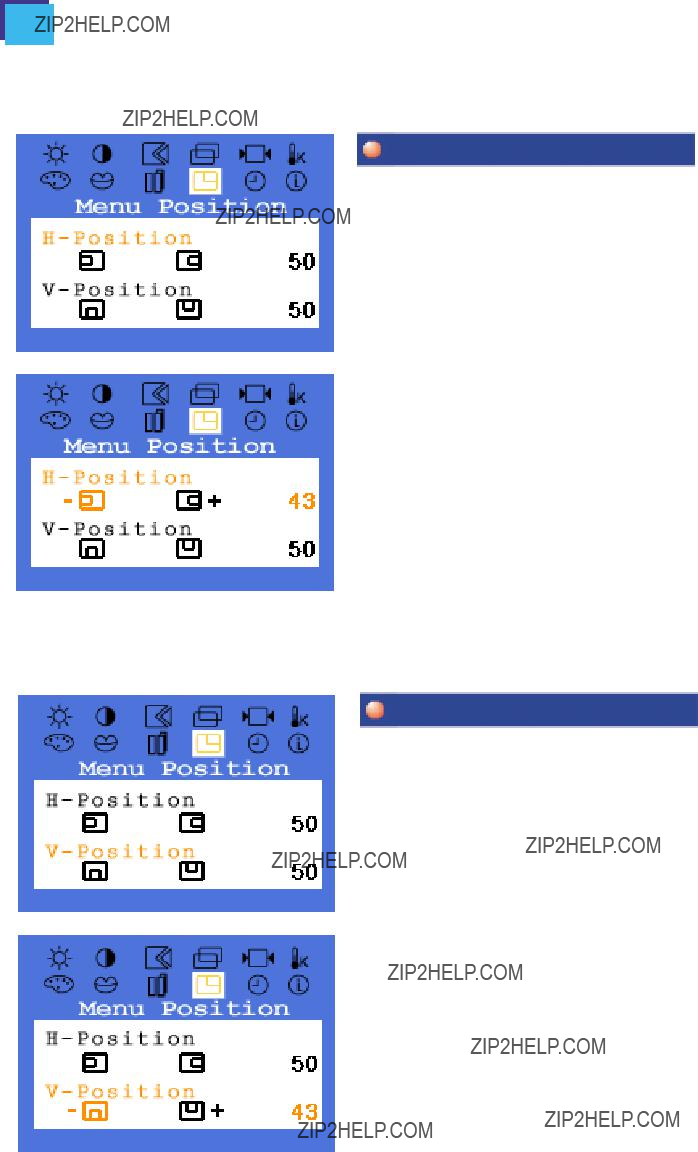
Menu Position
Menu
- You can change the horizontal position where the OSD menu appears on your monitor.
1. Push the Menu button.
2. Push the [ - ] button or [ + ] button until the Menu Position screen is displayed.
3. Push the Menu button twice to open the
4. Use the [ - ] button or [ + ] button to place the menu in the horizontal position you prefer.
Menu
- You can change the vertical position where the OSD menu appears on your monitor.
1. Push the Menu button.
2. Push the [ - ] button or [ + ] button until the Menu Position screen is displayed.
3. Push the Menu button again and then press the [ - ] or [ + ] button until the
4. Push the Menu button to open the
5. Use the [ - ] button or [ + ] button to place the menu in the vertical position you prefer.

Menu Display Time
Menu Display Time
- The menu will automatically turn off if no adjustments are made for a certain time period.
You can set the amount of time the menu will wait before it turns off.
1. Push the Menu button.
2. Push the [ - ] button or [ + ] button until the Menu Display Time screen is displayed.
3. Push the Menu button to open the Menu Display Time selection screen.
4. Use the [ - ] button or [ + ] button to select 5, 10, 20, 50, 200 seconds. 20 seconds is the default value.
Display Mode
Display Mode
- You can see the frequency, the polarity of the operational signals and
the resolution level.
Note : These screens do not allow any changes to the settings, they are for information only.
1. Push the Menu button.
2. Push the [ - ] button or [ + ] button until until the Display Mode screen is displayed.

Auto Adjustment
Auto Adjustment
- Auto adjustment allows the monitor to
The values of fine, coarse and position are adjusted automatically.
1. Push the Auto button.
Note : To make the automatic adjustment function sharper, execute the 'AUTO'
function while the AUTO PATTERN is on.
Note: Not Available
This function doesn't work in
Digital input.
OSD Lock / Unlock
OSD Lock/Unlock
1. Push and hold in the Menu button for
5 seconds or more to Lock the OSD.
2. Push and hold in the Menu button for
5 seconds or more to Unlock the OSD.

Magic Bright
Magic Bright
1. Push the MagicBright button.
Text:
Normal Brightness
For documentations or works involving heavy text.
Internet:
Medium Brightness
For working with mixture of contents such as
text and graphics.
Entertain:
High Brightness
For watching motion pictures such as DVD and VCD

SyncMaster 152x
 Check List
Check List
Before calling for service, check the information in this section to see if you can remedy any problems yourself. If you do need assistance, please call the phone number on the warranty card, the phone number on the Information section or contact your dealer.
 Q & A
Q & A
Check
Symptom
No images on the screen. I cannot turn on the monitor.
I cannot see the On Screen Display.
The screen shows strange colors or just black and white.
If the power is on, reboot the computer to see the initial screen(the login screen), which can be seen.
Can you see "Video mode not supported" on the screen?
There is no image on the screen. Is the power indicator on the monitor blinking at 1 second intervals?
Have you locked the On Screen Display (OSD) Menu to prevent changes?
Is the screen displaying only one color as if looking at the screen through a cellophane paper?
Have the screen colors become strange after running a program or due to a crash between applications?
If the initial screen (the login screen) appears, boot the computer in the applicable mode (the safe mode for Windows ME/XP/2000 ) and then change the frequency of the video card.
(Refer to the Preset Display Modes)
Note: If the initial screen (the login screen) does not appear, contact a service center or your dealer.
You can see this message when the signal from the video card exceeds the maximum resolution and frequency that the monitor can properly handle.
Adjust the maximum resolution and frequency that the monitor can properly handle.
The monitor is in PowerSaver mode.
Press a key on the keyboard or move the mouse to activate the monitor and restore the image on the screen.
Unlock the OSD by pressing the MENU button for at least 5 seconds.
Check the signal cable connection.
Make sure the video card is fully inserted in it's slot.
Reboot the computer.
The screen suddenly has become

Adjust the resolution and frequency at the video card.
(Refer to the Preset Display Modes).
The screen can be unbalanced due to the cycle of the video card signals. Readjust Position by referring to the OSD.
The screen is out of focus or OSD cannot be adjusted.
LED is blinking but no images on the screen.
There are only 16 colors shown on the screen. The screen colors have changed after changing the video card.
There is a message that reads "Unrecognized monitor, Plug & Play (VESA DDC) monitor found".
Have you adjusted the resolution or frequency on the monitor?
Is the frequency properly adjusted when checking the Display Timing on the menu?
Have the Windows colors been set properly?
Has the video card been set properly?
Have you installed the monitor driver?
See the video card manual to see if the Plug & Play (VESA DDC) function can be supported.
Adjust the resolution and frequency of the video card.
(Refer to the Preset Display Modes).
Adjust the frequency properly by referring to the video card manual and the Preset Display Modes.
(The maximum frequency per resolution may differ from product to product.)
For Windows ME/XP/2000 : Set the colors properly at the
Control Panel, Display, Settings.
Set the video card by referring to the video card manual.
Install the monitor driver according to the Driver Installation Instructions.
Install the monitor driver according to the Driver Installation Instructions.
Check the following items if there is trouble with the monitor.
1.Check if the power cord and the cable are properly connected to the computer.
2.Check if the computer beeps more than 3 times when booting.
(If it does, request an
3.If you installed a new video card or if you assembled the PC, check if the installed the adapter (video) driver and the monitor driver.
4.Check if the scanning ratio of the video screen is set at 75Hz or 85Hz. (Do not exceed 60Hz when using the maximum resolution.)
5.If you have problems in installing the adapter (video) driver, boot the computer in Safe Mode, remove the Display Adapter at the "Control Panel, System, Device Administrator" and then reboot the computer to reinstall the adapter (video) driver.
Note: If problems repeatedly occur, contact an authorized service center.
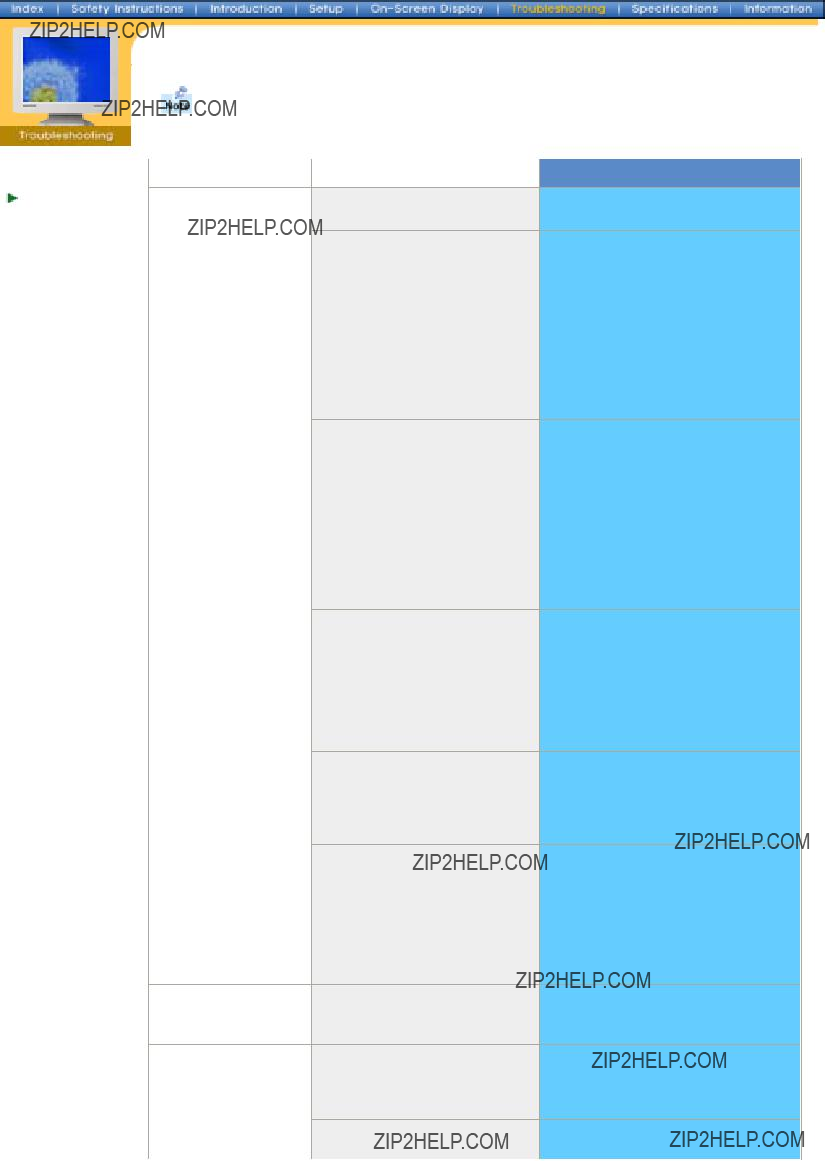
SyncMaster 172x
Before calling for service, check the information in this section to see if you can remedy any problems yourself. If you do need assistance, please call the phone number on the warranty card, the phone number on the Information section or contact your dealer.
 Check List
Check List
 Q & A
Q & A
Solutions
Check
No images on the screen. I cannot turn on the monitor.
I cannot see the On Screen Display.
The screen shows strange colors or just black and white.
Is the power cord connected properly?
Can you see "No Connection, Check Signal Cable" on the screen?
If the power is on, reboot the computer to see the initial screen (the login screen), which can be seen.
Can you see "Video mode not supported" on the screen?
There is no image on the screen. Is the power indicator on the monitor blinking at 1 second intervals?
Connected using the DVI cable?
Have you locked the On Screen Display (OSD) Menu to prevent changes?
Is the screen displaying only one color as if looking at the screen through a cellophane paper?
Have the screen colors become
Check the power cord connection and supply.
(Connected using the
Compruebe que el equipo est?? conectado correctamente.
(Connected using the DVI cable)
If you still see an (error) message on the screen when the monitor is connected properly, check to see if the monitor status is set to analogue. Press Source button to have the monitor
If the initial screen (the login screen) appears, boot the computer in the applicable mode (the safe mode for Windows ME/2000/XP) and then change the frequency of the video card.
(Refer to the Preset Display Modes)
Note: If the initial screen (the login screen) does not appear, contact a service center or your dealer.
You can see this message when the signal from the video card exceeds the maximum resolution and frequency that the monitor can properly handle.
Adjust the maximum resolution and frequency that the monitor can properly handle.
The monitor is in PowerSaver mode.
Press a key on the keyboard or move the mouse to activate the monitor and restore the image on the screen.
You may get a blank screen if you boot the system before you connect the DVI cable, or disconnect and then reconnect the DVI cable while the system is running as certain types of graphic cards do not send out video signals. Connect the DVI cable and then reboot the system.
Unlock the OSD by pressing the MENU button for at least 5 seconds.
Check the signal cable connection.
Make sure the video card is fully inserted in it's slot.
Reboot the computer.

The screen suddenly has become unbalanced.
strange after running a program or due to a crash between applications?
Has the video card been set properly?
Have you changed the video card or the driver?
Have you adjusted the resolution or frequency to the monitor?
Set the video card by referring to the video card manual.
Adjust screen image position and size using the OSD.
Adjust the resolution and frequency at the video card.
(Refer to the Preset Display Modes).
The screen is out of focus or OSD cannot be adjusted.
The screen can be unbalanced due to the cycle of the video card signals. Readjust Position by referring to the OSD.
LED is blinking but no images on the screen.
There are only 16 colors shown on the screen. The screen colors have changed
Is the frequency properly adjusted when checking the Display Timing on the menu?
Have the Windows colors been set properly?
Adjust the frequency properly by referring to the video card manual and the Preset Display Modes.
(The maximum frequency per resolution may differ from product to product.)
For Windows ME/2000/XP:
Set the colors properly at the Control Panel, Display, Settings.
after changing the video card.
There is a message that reads "Unrecognized monitor, Plug & Play (VESA DDC) monitor found".
Has the video card been set properly?
Have you installed the monitor driver?
See the video card manual to see if the Plug & Play (VESA DDC) function can be supported.
Set the video card by referring to the video card manual.
Install the monitor driver according to the Driver Installation Instructions.
Install the monitor driver according to the Driver Installation Instructions.
Check the following items if there is trouble with the monitor.
1.Check if the power cord and the cable are properly connected to the computer.
2.Check if the computer beeps more than 3 times when booting.
(If it does, request an
3.If you installed a new video card or if you assembled the PC, check if the installed the adapter (video) driver and the monitor driver.
4.Check if the scanning ratio of the video screen is set at 85Hz.
5.If you have problems in installing the adapter (video) driver, boot the computer in Safe Mode, remove the Display Adapter at the "Control Panel, System, Device Administrator" and then reboot the computer to reinstall the adapter (video) driver.
Note: If problems repeatedly occur, contact an authorized service center.
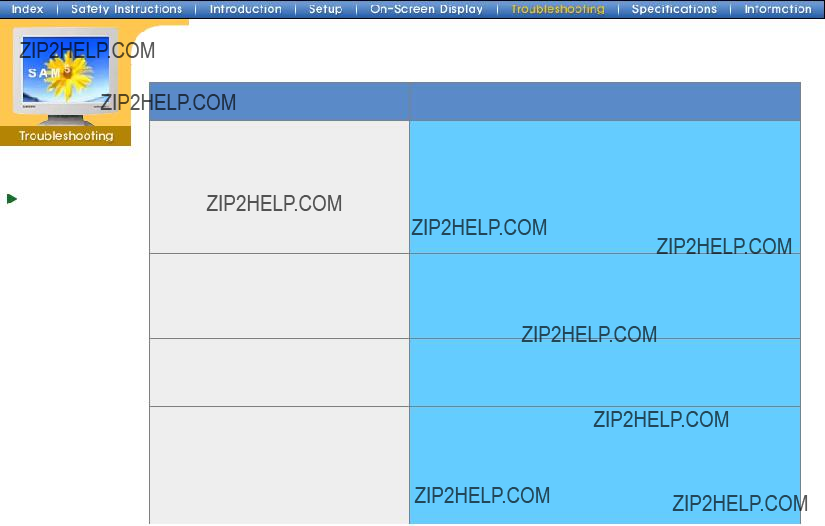
 Check List
Check List
 Q & A
Q & A
Check
Question
How can I change the frequency?
How can I adjust the resolution?
How can I set the Power Saving function?
How can I clean the outer case/LCD Panel?
Answer
Frequency can be changed by reconfiguring the video card.
Note that video card support can vary, depending on the version of the driver used.
(Refer to the computer or the video card manual for details.)
Windows ME/XP/2000 : Set the resolution at the Control Panel, Display, Settings.
* Contact the video card manufacturer for details.
Windows ME/XP/2000 : Set the function at
Disconnect the power cord and then clean the monitor with a soft cloth, using either a cleaning solution or plain water.
Do not leave any remains of the detergent nor scratch the case. Do not allow any water to go inside the monitor.
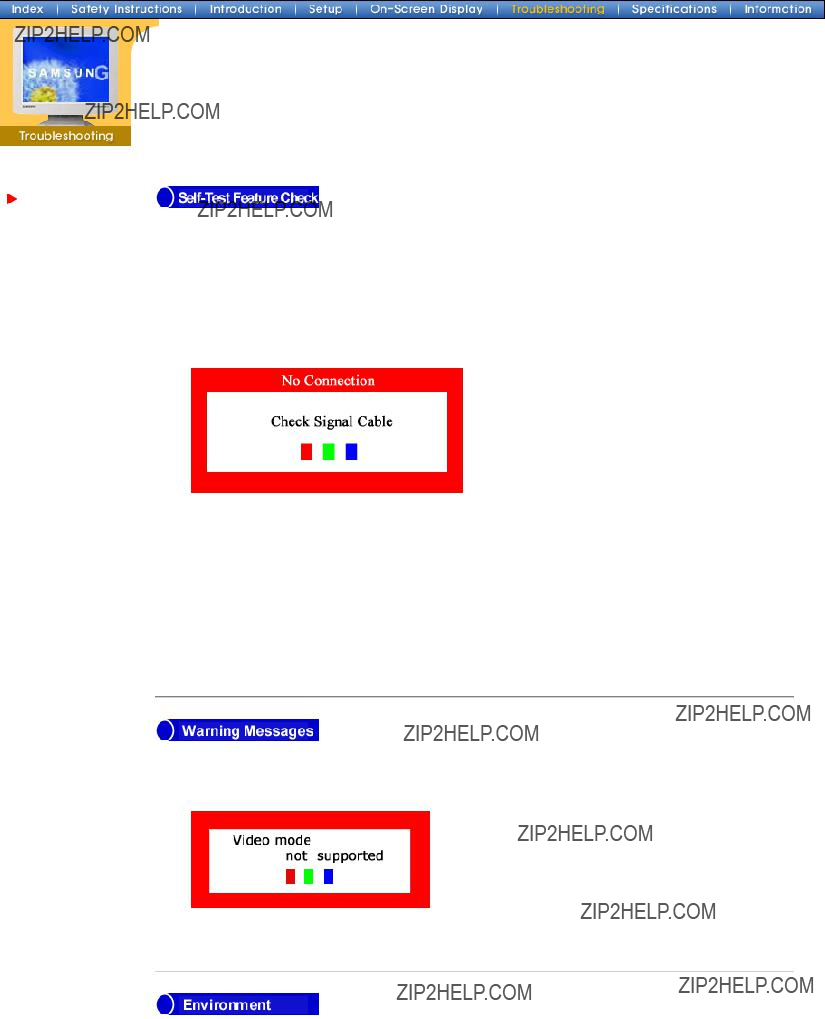
 Check List
Check List
 Q & A
Q & A
Feature Check
Your monitor provides a self test feature that allows you to check whether your monitor is functioning properly.
1.Turn off both your computer and the monitor.
2.Unplug the video cable from the back of the computer.
3.Turn on the monitor.
If the monitor is functioning properly, you will see a box with a border and text inside as shown in the following illustration:
The three boxes inside the border are red, green and blue.
Failure of any of the boxes to appear indicates a problem with your monitor. This box also appears during normal operation if the video cable becomes disconnected or damaged.
4.Turn off your monitor and reconnect the video cable; then turn on both your computer and the monitor.
If your monitor screen remains blank after using the previous procedure, check your video controller and computer system; your monitor is functioning properly.
If there is something wrong with the input signal, a message appears on the screen or the screen goes blank although the power indicator LED is still on. The message may indicate that the monitor is out of scan range or that you need to check the signal cable.
The location and the position of the monitor may influence the quality and other features of the monitor.
1.If there are any woofer speakers near the monitor, unplug and relocate the woofer to another room.
2.Remove all electronic devices such as radios, fans, clocks and telephones that are within 3

feet (one meter) of the monitor.
zA monitor recreates visual signals received from the PC. Therefore, if there is trouble with the PC or the video card, this can cause the monitor to become blank, have poor coloring, noise, Video mode not supported, etc. In this case, first check the source of the problem, and then contact a service center or your dealer.
zJudging the monitor's working condition
If there is no image on the screen or an "Video mode not supported" message comes up, disconnect the cable from the computer while the monitor is still powered on.
{If there is a message coming up on the screen or if the screen goes white, this means the monitor is in working condition.
{In this case, check the computer for trouble.

 General
General
 PowerSaver
PowerSaver
Preset Timing
Modes
General
RGB Analog 0.7 Vpp positive at 75 ohms
Separate H/V sync, SOG(Option), TTL level positive or negative
Maximum Pixel Clock
80 MHz
Power Supply
AC 90 ~ 264 VAC, 60/50 Hz ?? 3Hz
Signal Cable
Power Consumption
30W (Maximum)
Dimensions (WxDxH)/ Weight
326.3 x 158.7 x 314.3 mm / 2.5 kg
326.3 x 49.5 x 267.1 mm(After folding the stand)
VESA Mounting Interface
75mm x 75mm (for use with Specialty(Arm) Mounting hardware.)
Environmental considerations
Plug and Play Capability
This monitor can be installed on any Plug & Play compatible system. Interaction of the monitor and computer systems will provide the best operating conditions and monitor settings. In most cases, monitor installation will proceed automatically, unless the user wishes to select alternate settings.
Dot Acceptable

TFT LCD panel manufactured by using advanced semiconductor technology with precision of 99.999% above is used for this product. But the pixels of RED, GREEN, BLUE and WHITE color seem to be bright sometimes or some of black pixels could be seen. This is not from bad quality and you can use it without uneasiness.
z For example, the number of TFT LCD pixels that is contained in this product are 2.359.296.
Note: Design and specifications are subject to change without prior notice.

 General
General
 PowerSaver
PowerSaver
Preset Timing
Modes
General
RGB Analog 0.7 Vpp positive at 75 ohms
Separate sync,Composite H/V sync , SOG(Option), TTL level positive or negative
Maximum Pixel Clock
135 MHz
Power Supply
AC 90 ~ 264 VAC, 60/50 Hz ?? 3Hz
Signal Cable
Power Consumption
40W (Maximum)
Dimensions (WxDxH)/ Weight
361.6 x 193.9 x 363.0 mm / 3.75 kg
361.6 x 55.0 x 330.6 mm (After folding the stand)
VESA Mounting Interface
75mm x 75mm (for use with Specialty(Arm) Mounting hardware.)
Environmental considerations
Plug and Play Capability
This monitor can be installed on any Plug & Play compatible system. Interaction of the monitor and computer systems will provide the best operating conditions and monitor settings. In most cases, monitor installation will proceed automatically, unless the user wishes to select alternate settings.

Dot Acceptable
TFT LCD panel manufactured by using advanced semiconductor technology with precision of 99.999% above is used for this product. But the pixels of RED, GREEN, BLUE and WHITE color seem to be bright sometimes or some of black pixels could be seen. This is not from bad quality and you can use it without uneasiness.
z For example, the number of TFT LCD pixels that is contained in this product are 2.359.296.
Note: Design and specifications are subject to change without prior notice.

SyncMaster 152x
 General
General
 PowerSaver
PowerSaver
Preset Timing
Modes
This monitor has a
This monitor is EPA ENERGY STAR?? compliant and ENERGY2000 compliant when used with a computer equipped with VESA DPMS functionality.
As an ENERGY STAR?? Partner, SAMSUNG has determined that this product meets the ENERGY STAR?? guidelines for energy efficiency.

SyncMaster 172x
 General
General
 PowerSaver
PowerSaver
Preset Timing
Modes
This monitor has a
This monitor is EPA ENERGY STAR?? compliant and ENERGY2000 compliant when used with a computer equipped with VESA DPMS functionality.
As an ENERGY STAR?? Partner, SAMSUNG has determined that this product meets the ENERGY STAR?? guidelines for energy efficiency.

SyncMaster 152x
 General
General
 PowerSaver
PowerSaver
Preset Timing
Modes
If the signal transferred from the computer is the same as the following Preset Timing Modes, the screen will be adjusted automatically. However, if the signal differs, the screen may go blank while the power LED is on. Refer to the video card manual and adjust the screen as follows.
Table 1. Preset Timing Modes
Horizontal Frequency
The time to scan one line connecting the right edge to the left edge of the screen horizontally is called Horizontal Cycle and the inverse number of the Horizontal Cycle is called Horizontal Frequency. Unit: kHz
Vertical Frequency
Like a fluorescent lamp, the screen has to repeat the same image many times per second to display an image to the user. The frequency of this repetition is called Vertical Frequency or Refresh Rate. Unit: Hz

SyncMaster 172x
 General
General
 PowerSaver
PowerSaver
Preset Timing
Modes
If the signal transferred from the computer is the same as the following Preset Timing Modes, the screen will be adjusted automatically. However, if the signal differs, the screen may go blank while the power LED is on. Refer to the video card manual and adjust the screen as follows.
Horizontal Frequency
The time to scan one line connecting the right edge to the left edge of the screen horizontally is called Horizontal Cycle and the inverse number of the Horizontal Cycle is called Horizontal Frequency. Unit: kHz
Vertical Frequency
Like a fluorescent lamp, the screen has to repeat the same image many times per second to display an image to the user. The frequency of this repetition is called Vertical Frequency or Refresh Rate. Unit: Hz

Service
 Terms
Terms
 Regulatory
Regulatory
 Natural Color
Natural Color
 For Better Display
For Better Display
 Authority
Authority
U.S.A. :
Samsung Computer Products Customer Service 400 Valley Road, Suite 201, Mt. Arlington, NJ 07856
Tel. :
Fax. :
BRAZIL :
Samsung Eletronica da Amazonia Ltda.
R. Prof. Manoelito de Ornellas, 303, Terro B Chacara Sto. Antonio, CEP :
SAC : 0800 124 421 http://www.samsung.com.br/
CANADA :
Samsung Electronics Canada Inc. 7037 Financial Drive Mississauga, Ontario L5N 6R3
Tel. :
Fax. : (905)
COLOMBIA :
Samsung Electronics Colombia Cra 9 No
Tel.:
Fax: (571) 618 - 2068
PANAMA :
Samsung Electronics Latinoamerica( Z.L.) S.A. Calle 50 Edificio Plaza Credicorp, Planta Baja Panama
Tel. : (507)
Tel :
PERU
Servicio Integral Samsung
Av.Argentina 1790 Lima1. Peru
Tel:
Fax:
http://www.samsungperu.com/
GERMANY :
TELEPLAN
64331 Weiterstadt
T.
F.
* EURO 0,12/MIN. http://www.samsung.de/
AUSTRALIA :
Samsung Electronics Australia Pty Ltd. Customer Response Centre
7 Parkview Drive, Homebush Bay NSW 2127 Tel : 1300 362 603 http://www.samsung.com.au/
ITALY :
Samsung Electronics Italia S.p.a. Via C. Donat Cattin, 5
20063 Cernusco s/Naviglio (MI) Servizio Clienti: 199.153.153

ESPA??A :
Samsung Electronics Comercial Iberica, S.A.
Ciencies,
Hospitalet de Llobregat (Barcelona)
Tel. : (93) 261 67 00
Fax. : (93) 261 67 50
http://samsung.es/
United Kingdom :
Samsung Electronics (UK) Ltd. Samsung House, 225 Hook Rise South Surbiton, Surrey KT6 7LD
Tel. : (0208) 391 0168
Fax. : (0208) 397 9949
< European Service Center & National Service > Stafford Park 12 Telford, Shropshire, TF3 3BJ Tel. : (0870) 242 0303
Fax. : (01952) 292 033 http://samsungservice.co.uk/
THAILAND :
HAI SAMSUNG SERVICE CENTER MPA COMPLEX
175 SOI SUEKSA VIDHAYA SATHON SOI 12
SILOM ROAD ,SILOM,BANGRAK BANGKOK 10500
TEL :
FAX :
SOUTH AFRICA :
Samsung Electronics,5 Libertas Road, Somerset Office Park, Bryanston Ext 16. Po Box 70006, Bryanston,2021, South Africa Tel :
Fax :
UKRAINE :
SAMSUNG ELECTRONICS REPRESENTATIVE OFFICE IN UKRAINE 4 Glybochitska str.
Kiev, Ukraine
Tel.
Fax
SWEDEN/DENMARK/NORWAY/FINLAND :
Samsung Electronics AB
Box 713
SVERIGE
Bes??ksadress : Johanneslundsv??gen 4
Samsung support Sverige:
Samsung support Danmark :
Samsung support Norge:
Samsung support Finland:
Tel +46 8 590 966 00
Fax +46 8 590 966 50
http://www.samsung.se/
HUNGARY :
Samsung Electronics Magyar Rt. 1039, Budapest, Lehel u.
Fax: 36 1 453 1101 http://www.samsung.hu/
FRANCE :
SAMSUNG ELECTRONICS FRANCE Service Paris Nord 2
66 rue des Vanesses BP 50116 Villepinte 95950 Roissy CDG Cedex Tel : 08 25 08 65 65
Fax : 01 48 63 06 38 http://www.samsungservices.com/
PORTUGAL :
SAMSUNG ELECTRONICA PORTUGUESA S.A.
Rua M??rio Dioniso, No2 - 1?? Drt.

Free Line 800 220 120
http://www.samsung.pt/
NETHERLANDS/BELGIUM/LUXEMBOURG :
Samsung Electronics Benelux B. V.
Fleminglaan 12 2289 CP Rijiswijk, NEDERLANDS
Service and informatielijn ;
Netherlands :
CHILE :
SONDA S.A.
Teatinos 550, Santiago Centro, Santiago, Chile Fono:
http://www.sonda.com/
http://www.samsung.cl/
MEXICO :
Samsung Electronics Mexico S.A. de C.V.
Saturno No.44, Col. Nueva Industrial Vallejo
Gustavo A. Madero C.P. 07700, Mexico D.F. Mexico
Tel. 52 55 57 47 51 00
Fax. 52 55 57 47 52 02
RFC: SEM950215S98
http://www.samsung.com.mx/
IMPORTADO POR: SAMSUNG ELECTRONICS MEXICO. S.A. DE C.V. Saturno No.44, Col, Nueva Industrial Vallejo Gustavo A.Madero C.P. 07700, Mexico D.F. Mexico TEL.
EXPORTADO POR: Samsung Electronics Co., Ltd.
416, Mae
Suwon City,

Service
 Terms
Terms
 Regulatory
Regulatory
 Natural Color
Natural Color
 For Better Display
For Better Display
 Authority
Authority
 Dot Pitch
Dot Pitch
The image on a monitor is composed of red, green and blue dots. The closer the dots, the higher the resolution. The distance between two dots of the same color is called the 'Dot Pitch'. Unit: mm
 Vertical Frequency
Vertical Frequency
The screen must be redrawn several times per second in order to create and display an image for the user. The frequency of this repetition per second is called Vertical Frequency or Refresh Rate. Unit: Hz
Example: If the same light repeats itself 60 times per second, this is regarded as 60 Hz. In this case, flickering of the screen can be detected. To avoid this problem, there is a
 Horizontal Frequency
Horizontal Frequency
The time to scan one line connecting the right edge to the left edge of the screen horizontally is called Horizontal Cycle. The inverse number of the Horizontal Cycle is called Horizontal Frequency. Unit: kHz
 Interlace and
Interlace and
Showing the horizontal lines of the screen from the top to the bottom in order is called the Non- Interlace method while showing odd lines and then even lines in turn is called the Interlace method. The
 Plug & Play
Plug & Play
This is a function that provides the best quality screen for the user by allowing the computer and the monitor to exchange information automatically. This monitor follows the international standard VESA DDC for the Plug & Play function.
 Resolution
Resolution
The number of horizontal and vertical dots used to compose the screen image is called 'resolution'. This number shows the accuracy of the display. High resolution is good for performing multiple tasks as more image information can be shown on the screen.
Example: If the resolution is 1280 X 1280, this means the screen is composed of 1280 horizontal dots (horizontal resolution) and 1280 vertical lines (vertical resolution).

Service
 Terms
Terms
 Regulatory
Regulatory
 Natural Color
Natural Color
 For Better Display
For Better Display
 Authority
Authority
FCC Information | IC Compliance Notice | MPR II Compliance
European Notice (Europe only) | PCT Notice | VCCI |
TCO'03 Recycling Information (TCO'03 applied model only)
Medical Requirement
 FCC Information
FCC Information
User Instructions
The Federal Communications Commission Radio Frequency Interference Statement includes the following warning:
Note: This equipment has been tested and found to comply with the limits for a Class B digital device, pursuant to Part 15 of the FCC Rules. These limits are designed to provide reasonable protection against harmful interference in a residential installation. This equipment generates, uses, and can radiate radio frequency energy and, if not installed and used in accordance with the instructions, may cause harmful interference to radio communications. However, there is no guarantee that interference will not occur in a particular installation. If this equipment does cause harmful interference to radio or television receptions, which can be determined by turning the equipment off and on, the user is encouraged to try to correct the interference by one or more of the following measures:
zReorient or relocate the receiving antenna.
zIncrease the separation between the equipment and receiver.
zConnect the equipment into an outlet on a circuit different from that to which the receiver is connected.
zConsult the dealer or an experienced radio/TV technician for help.
User Information
Changes or modifications not expressly approved by the party responsible for compliance could void the user's authority to operate the equipment. If necessary, consult your dealer or an experienced radio/television technician for additional suggestions. You may find the booklet called How to Identify and Resolve Radio/TV Interference Problems helpful. This booklet was prepared by the Federal Communications Commission. It is available from the U.S. Government Printing Office, Washington, DC 20402, Stock Number
The party responsible for product compliance:
SAMSUNG ELECTRONICS CO., LTD America QA Lab of Samsung
3351 Michelson Drive,
Suite #290, Irvine, CA92612 USA Tel)
Fax)
Warning
User must use shielded signal interface cables to maintain FCC compliance for the product.
Provided with this monitor is a detachable power supply cord with IEC320 style terminations. It may be suitable for connection to any UL Listed personal computer with similar configuration. Before making the connection, make sure the voltage rating of the computer convenience outlet is the same as the monitor and that the ampere rating of the computer convenience outlet is equal to or exceeds the monitor voltage rating.
For 120 Volt applications, use only UL Listed detachable power cord with NEMA configuration 5- 15P type (parallel blades) plug cap. For 240 Volt applications use only UL Listed Detachable power supply cord with NEMA configuration
 IC Compliance Notice
IC Compliance Notice
This Class B digital apparatus meets all requirements of the Canadian

Cet appareil Num??rique de classe B respecte toutes les exigences du R??glemont
 MPR II Compliance
MPR II Compliance
This monitor complies with SWEDAC(MPR II) recommendations for reduced electric and magnetic fields.
 European Notice(Europe Only)
European Notice(Europe Only)
Products with the CE marking comply with the EMC Directive(89/336/EEC), (92/31/EEC), (93/68/EEC) and the Low Voltage Directive (73/23/EEC) issued by the Commission of the European Community.
Compliance with these directives implies conformity to the following European Norms:
zEN55022:1998+A1:2000 - Radio Frequency Interference
zEN55024:1998 - Electromagnetic Immunity of Information Technology Equipment
z
z
 PCT Notice
PCT Notice
 VCCI
VCCI
This is a Class B product based on the standard of the Voluntary Control Council for Interference by Information Technology Equipment (VCCI). If this is used near a radio or television receiver in a domestic environment, it may cause radio interference. Install and use the equipment according to the instruction manual.

AB general requirements
AB2 Written
Congratulations! You have just purchased a TCO'95 approved and labelled product! Your choice has provided you with a product developed for professional use. Your purchase has also contributed to reducing the burden on the environment and to the further development of
Why do we have
In many countries, environmental labelling has become an established method for encouraging the adaptation of goods and services to the environment.The main problem as far as monitors and other electronic equipment are concerned is that environmentally harmful substances are used both in the products and during their manufacture. Since it has not been possible so far for the majority of electronic equipment to be recycled in a satisfactory way, most of these potentially damaging substances sooner or later enter Nature.
There are also other characteristics of a monitor, such as energy consumption levels, that are important from both the working and natural environment viewpoints. Since all types of conventional electricity generation have a negative effect on the environment (acidic and climate- influencing emissions, radioactive waste, etc.) it is vital to conserve energy. Electronic equipment in offices consumes an enormous amount of energy, since it is often routinely left running continuously.
What does labelling involve?
This product meets the requirements for the TCO'95 scheme, which provides for international environmental labelling of monitors. The labelling scheme was developed as a joint effort by the TCO (The Swedish Confederation of Professional Employees), Naturskyddsforeningen (The Swedish Society for Nature Conservation) and NUTEK (The National Board for Industrial and Technical Development in Sweden).
The requirements cover a wide range of issues: environment, ergonomics, usability, emission of electrical and magnetic fields, energy consumption and electrical and fire safety.
The environmental demands concern among other things restrictions on the presence and use of heavy metals, brominated and chlorinated flame retardants, CFCs (freons), and chlorinated solvents. The product must be prepared for recycling and the manufacturer is obliged to have an environmental plan, which must be adhered to in each country where the company conducts its operations policy. The energy requirements include a demand that the monitor after a certain period of inactivity shall reduce its power consumption to a lower level, in one or more stages. The length of time to reactivate the monitor shall be reasonable for the user.
Labelled products must meet strict environmental demands, for example in respect of the reduction of electric and magnetic fields, along with physical and visual ergonomics and good usability.
TCO Development Unit
On the page this folder you will find a brief summary of the environmental requirements met by this product.
The complere environmental criteria document may be ordered from: TCO Development Unit
Fax: +46 8 782 92 07
Current information regarding
TCO'95 is a
Environmental Requirements
Brominated flame retardants are present in printed circuit boards, cables, wires, casings and housings. In turn, they delay the spread of fire. Up to thirty percent of the plastic in a computer casing can consist of flame retardant substances. These are related to another group of environmental toxins, PCBs, which are suspected to give rise to similar harm, including reproductive damage in fish eating birds and mammals, due to the bioaccumulative processes. Flame retardants have been found in human blood and researchers fear that disturbances in foetus development may occur.
z TCO'95 demand requires that plastic components weighing more than 25 grams must not contain organically bound chlorine and bromine.
Lead
Lead can be found in picture tubes, display screens, solders and capacitors. Lead damages the nervous system and in higher doses, causes lead poisoning.
z TCO'95 requirement Permits the inclusion of lead since no replacement has yet been developed.
Cadmium
Cadmium is present in rechargeable batteries and in the colour generating layers of certain computer displays. Cadmium damages the nervous system and is toxic in high doses.
z TCO'95 requirement states that batteries may not contain more than 25 ppm (parts per million) of cadmium. The

Mercury
Mercury is sometimes found in batteries, relays and switches. Mercury damages the nervous system and is toxic in high doses.
z TCO'95 requirement states that batteries may not contain more than 25 ppm (parts per million) of mercury. It also demands that no mercury is present in any of the electrical or electronics components concerned with the display unit.
CFCs (freons)
CFCs (freons) are sometimes used for washing printed circuit boards and in the manufacturing of expanded foam for packaging. CFCs break down ozone and thereby damage the ozone layer in the stratosphere, causing increased reception on Earth of ultraviolet light with consequent increased risks of skin cancer (malignant melanoma).
z The relevant TCO'95 requirement: Neither CFCs nor HCFCs may be used during the manufacturing of the product or its packaging.

Congratulations!
You have just purchased a TCO'99 approved and labelled product! Your choice has provided you with a product developed for professional use. Your purchase has also contributed to reducing the burden on the environment and also to the further development of environmentally adapted electronics products.
This product meets the requirements for the TCO'99 scheme which provides for an international environmental and quality labelling labelling of personal computers. The labelling scheme was developed as a joint effort by the TCO(The Swedish Confederation of Professional Employees), Svenska Naturskyddsforeningen(The Swedish Society for Nature Conservation), Statens Energimyndighet(The Swedish National Energy Administration) and SEMKO AB.
The requirements cover a wide range of issuse: environment, ergonomics, usability, reduction of electric and magnetic fields, energy consumption and electrical safety.
Why do we have environmentally labelled computers?
In many countries, environmental labelling has become an established method for encouraging the adaptation of goods and services to the environment. The main problem, as far as computers and other electronics equipment are concerned, is that environmentally harmful substances are used both in the products and during their manufacture. Since it is not so far possible to satisfactorily recycle the majority of electronics equipment, most of these potentially damaging substances sooner or later enter nature.
There are also other characteristics of a computer, such as energy consumption levels, that are important from the viewpoints of both the work (internal) and natural (external) environments. Since all methods of electricity generation have a negative effect on the environment (e.g. acidic and
What does labelling involve?
The environmental demands has been developed by Svenska Naturskyddsforeningen (The Swedish Society for Nature Conservation). These demands impose restrictions on the presence and use of heavy metals, brominated and chlorinated flame retardants, CFCs(freons)and chlorinated solvents, among other things. The product must be prepared for recycling and the manufacturer is obliged to have an environmental policy which must be adhered to in each country where the company implements its operational policy.
The energy requirements include a demand that the computer and/or display, after a certain period of inactivity, shall reduce its power consumption to a lower level in one or more stages. The length of time to reactivate the computer shall be reasonable for the user.
Below you will find a brief summary of the environmental requirements met by this product. The complete environmental criteria document may be ordered from:

TCO Development
Fax: +46 8 782 92 07
Email (Internet): development@tco.se
Current information regarding TCO'99 approved and labelled products may also be obtained via the Internet, using the address:
Environmental requirements
Flame retardants
Flame retardants are present in printed circuit boards, cables, wires, casings and housings. Their purpose is to prevent, or at least to delay the spread of fire. Up to 30% of the plastic in a computer casing can consist of flame retardant substances. Most flame retardants contain bromine or chloride, and those flame retardants are chemically related to another group of environmental toxins, PCBs. Both the flame retardants containing bromine or chloride and the PCBs are suspected of giving rise to severe health effects, including reproductive damage in
The relevant TCO'99 demand requires that plastic components weighing more than 25 grams must not contain flame retardants with organically bound bromine or chlorine. Flame retardants are allowed in the printed circuit boards since no substitutes are available.
Cadmium**
Cadmium is present in rechargeable batteries and in the
Mercury**
Mercury is sometimes found in batteries, relays and switches. It damages the nervous system and is toxic in high doses. The relevant TCO'99 requirement states that batteries may not contain any mercury. It also demands that mercury is not present in any of the electrical or electronics components associated with the labelled unit. There is however one exception. Mercury is, for the time being, permitted in the back light system of flat panel monitors as today there is no commercially available alternative. TCO aims on removing this exception when a Mercury free alternative is available.
CFCs (freons)
The relevant TCO'99 requirement states that neither CFCs nor HCFCs may be used during the manufacture and assembly of the product. CFCs (freons) are sometimes used for washing printed circuit boards. CFCs break down ozone and thereby damage the ozone layer in the stratosphere, causing increased reception on earth of ultraviolet light with e.g. increased risks of skin cancer (malignant melanoma) as a consequence.
Lead**
Lead can be found in picture tubes, display screens, solders and capacitors. Lead damages the nervous system and in higher doses, causes lead poisoning. The relevant TCO'99 requirement permits the inclusion of lead since no replacement has yet been developed.

Congratulations!
The display you have just purchased carries the TCO???03 Displays label. This means that your display is designed, manufactured and tested according to some of the strictest quality and environmental requirements in the world. This makes for a high performance product, designed with the user in focus that also minimizes the impact on our natural environment.
Some of the features of the TCO???03 Display requirements:

Ergonomics
Good visual ergonomics and image quality in order to improve the working environment for the user and to reduce sight and strain problems. Important parameters are luminance, contrast, resolution, reflectance, colour rendition and image stability.
Energy
???
???Electrical safety
Emissions
???Electromagnetic fields
???Noise emissions
Ecology
???The product must be prepared for recycling and the manufacturer must have a certified environmental management system such as EMAS or ISO 14 000
???Restrictions on
o chlorinated and brominated flame retardants and polymers o heavy metals such as cadmium, mercury and lead.
The requirements included in this label have been developed by TCO Development in cooperation with scientists, experts, users as well as manufacturers all over the world. Since the end of the 1980s TCO has been involved in influencing the development of IT equipment in a more user- friendly direction. Our labelling system started with displays in 1992 and is now requested by users and
For more information, Please visit
www.tcodevelopment.com
 Medical Requirement
Medical Requirement
Classifications:
In accordance with UL
EMC
This equipment has been tested and found to comply with the limits for medical devices to the IEC
zReorient or relocate the receiving device.
zIncrease the separation between the equipment.
zConnect the equipment into an outlet on a circuit different from that to which the other device
(s) are connected.
zConsult the manufacturer or field service technician for help.
Video In / RS 232 / Video Out
Accessories equipment connected to the analog and digital interfaces must be certified to the respective IEC standards (i.e. IEC 950 for data processing equipment and IEC
Transport and Storage Limitations:
Temperature Range of
Relative Humidity of 10
*
**Lead, Cadmium and Mercury are heavy metals which are

 TCO'03 Recycling Information (TCO'03 applied model only)
TCO'03 Recycling Information (TCO'03 applied model only)
For recycling information for TCO'03 certified monitors, for the residents in the following countries, please contact the company corresponding to your region of residence. For those who reside in other countries, please contact a nearest local Samsung dealer for recycling information for the products to be treated in environmentally acceptable way.
[U.S.A. Residents Only]
[European Residents Only]
COMPANY
ADDRESS
TELEPHONE
FAX
HOME PAGE
U.S.A.
Solid Waste Transfer &
Recycling Inc
442 Frelinghuysen Ave Newark,
NJ 07114
none
http://www.bcua.org/
SolidWaste_Disposal.htm
SWEDEN
 ELKRETSEN
ELKRETSEN
ELKRETSEN Box 1357, 111 83 Stockholm Barnhusgatan 3, 4 tr.
 08-545
08-545
 info@el-kretsen.se
info@el-kretsen.se
http://www.el- kretsen.se/
NORWAY
Elektronikkretur AS
6454 Etterstad 0602 Oslo
Fyrstikkalln 3B
23 06 07 40
23 06 07 41
adm@elektronikkretur.no
http://www.elretur.no/
GERMANY
vfw AG
Max Plank Strasse 42
50858 Collogne Germany
49 0 2234 9587 -
0
vfw.info@vfw- ag.de
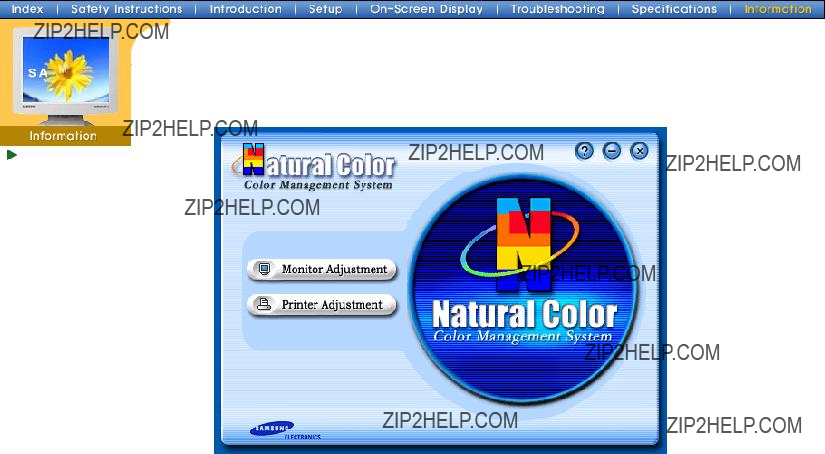
 Natural Color Software Program
Natural Color Software Program
Service
 Terms
Terms
 Regulatory
Regulatory
 Natural Color
Natural Color
 For Better Display
For Better Display
 Authority
Authority
One of the recent problems in using a computer is that the color of the images printed out by a printer or other images scanned by a scanner or a digital camera are not the same as those shown on the monitor.
The Natural Color S/W is the very solution for this problem. It is a color administration system developed by Samsung Electronics in association with Korea Electronics & Telecommunications Research Institute (ETRI). This system is available only for Samsung monitors and makes the color of the images on the monitor the same as the printed or scanned images.
For more information, refer to Help (F1) in the software program.
How to install the Natural Color software
Insert the CD included with the Samsung monitor into the
Enter D:\color\eng\setup.exe and then press the <Entrer> key.
(If the drive where the CD is inserted is not D:\, enter the applicable drive.)
How to delete the Natural Color software program
Select [Setting]/[Control Panel] on the [Start] menu and then
Select Natural Color from the list and then click the [Add/Delete] button.

Service
 Terms
Terms
 Regulatory
Regulatory
 Natural Color
Natural Color
For Better
Display
 Authority
Authority
For Better Display
1.Adjust computer resolution and screen injection rate (refresh rate) in control panel of computer as described below to enjoy the best quality of picture. You can have an uneven quality of picture in the screen if the best quality of picture is not provided in
{Resolution: 1024 x 768
{Vertical frequency (refresh rate): 60 Hz
2.TFT LCD panel manufactured by using advanced semiconductor technology with precision of 99.999% above is used for this product. But the pixels of RED, GREEN, BLUE and WHITE color seem to be bright sometimes or some of black pixels could be seen. This is not from bad quality and you can use it without uneasiness.
{For example, the number of TFT LCD pixels that is contained in this product are
2,359,296.
3.When you clean the monitor and the panel outside, please apply the recommended small amount of cleaner by using soft and dry cloth and polish it. Let LCD area not to be forced but to be scrubbed out softly. If excessive force is applied, you can have a stain on it.
4.If you are not satisfied with the quality of picture, you can get better quality of picture by executing "auto adjustment function" in display screen that is appeared as window termination button is pressed. If there's still noise after automatic adjustment, use FINE/COARSE adjustment function.
5.If you view a fixed screen for an extended period of time, residual image or blurriness may appear.
Change the mode to energy save or set a screensaver to moving picture when you need to be away from the monitor for an extended period of time.

Service
 Terms
Terms
 Regulatory
Regulatory
 Natural Color
Natural Color
 For Better Display
For Better Display
 Authority
Authority
Information in this document is subject to change without notice. ?? 2003 Samsung Electronics Co., Ltd. All rights reserved.
Reproduction in any manner whatsoever without the written permission of Samsung Electronics Co., Ltd. is strictly forbidden.
Samsung Electronics Co., Ltd. shall not be liable for errors contained herein or for incidental or consequential damages in connection with the furnishing, performance, or use of this material.
Samsung is the registered trademark of Samsung Electronics Co., Ltd.; Microsoft, Windows and Windows NT are registered trademarks of Microsoft Corporation; VESA, DPMS and DDC are registered trademarks of Video Electronics Standard Association; the ENERGY STAR name and logo are registered trademarks of the U.S. Environmental Protection Agency (EPA). As an ENERGY STAR Partner, Samsung Electronics Co., Ltd. has determined that this product meets the ENERGY STAR guidelines for energy efficiency. All other product names mentioned herein may be the trademarks or registered trademarks of their respective owners.